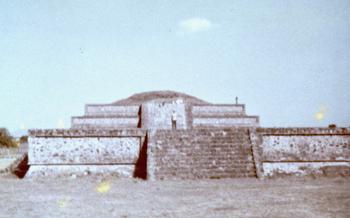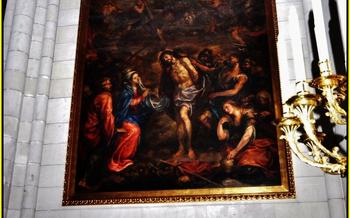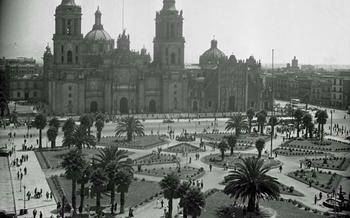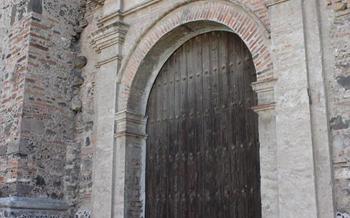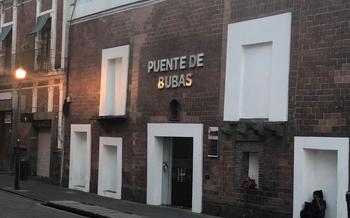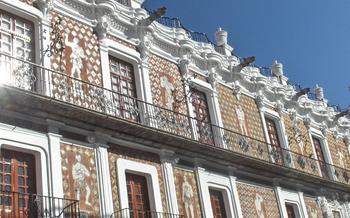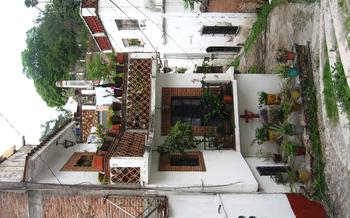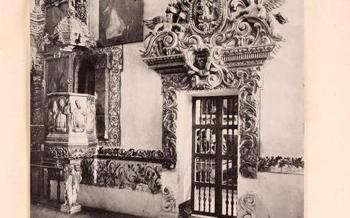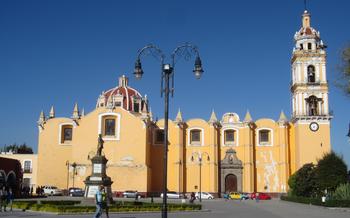
Templo Conventual de las Cinco Llagas de San Francisco
- History and Origins
- Architectural Marvel:
- Exploring the Interior
- Religious Significance:
- Cultural Heritage
- Visiting the Temple
- Unveiling the Secrets
- Local Traditions and Customs
- Events and Festivals
- Local Artisans and Crafts
- Gastronomic Delights
- Nearby Attractions
- Recommended Tours
- Insider Tip:
History and Origins
The Templo Conventual de las Cinco Llagas de San Francisco in Puebla, Mexico, holds a significant place in the city's history and the evangelization of the region. Its foundation dates back to 1531, shortly after the Spanish conquest of the Aztec Empire. Franciscan friars, driven by their missionary zeal, arrived in Puebla and established a humble chapel dedicated to Saint Francis of Assisi.
As the city grew and the Catholic faith spread, the need for a larger and more substantial church arose. In 1543, construction began on the current temple, under the patronage of the wealthy local family, the Carrillos. The Franciscan order played a pivotal role in the construction and administration of the temple, ensuring its completion in 161
The temple's strategic location within the city further enhanced its importance. Situated in the heart of Puebla, near the main square, it became a central point for religious ceremonies, community gatherings, and the dissemination of the Catholic faith. Over the centuries, the temple underwent various modifications and additions, reflecting the evolving architectural styles and tastes of the time.
Architectural Marvel:
The Templo Conventual de las Cinco Llagas Gothic influence is evident in its pointed arches, ribbed vaults, and intricate tracery. Renaissance elements, such as classical columns and pilasters, add a sense of balance and harmony to the exterior. The Baroque style, characterized by its exuberance and theatricality, is showcased in the elaborate ornamentation of the facade and the decorative flourishes in the interior.
The temple's facade is a masterpiece of stone carving, with intricate reliefs depicting scenes from the life of Saint Francis and the Five Wounds. The main portal features a series of niches housing statues of saints and prophets, while the upper section is adorned with a rose window surrounded by delicate stone carvings. The twin bell towers, rising majestically above the cityscape, showcase the temple's verticality and serve as a beacon for pilgrims and visitors alike.
Inside, the temple's grandeur continues. The nave is separated from the side aisles by rows of slender columns, creating a sense of spaciousness and luminosity. The ribbed vaults soar overhead, supported by intricate corbels and adorned with colorful frescoes depicting biblical scenes and the life of Saint Francis. The main altar, dedicated to the Five Wounds, is a masterpiece of Baroque art, with its gilded ornamentation and intricate carvings. The side chapels, each dedicated to a different saint or devotion, feature their own unique altars and decorative elements, showcasing the artistic diversity of the temple.
Exploring the Interior
Venturing inside the Templo Conventual de las Cinco L The awe-inspiring main altar, dedicated to the Five Wounds of Saint Francis, takes center stage, adorned with intricate carvings, gilded embellishments, and a stunning altarpiece depicting the crucifixion. The side chapels, each dedicated to a different saint or devotion, offer a diverse array of artistic treasures, from delicate frescoes to ornate sculptures.
The choir loft and organ, perched above the main entrance, showcase the temple's rich musical heritage. The elaborate carvings on the choir stalls and the majestic tones of the organ create a sense of grandeur that resonates throughout the sacred space. In the sacristy, visitors can marvel at a collection of valuable religious artifacts and vestments, providing a glimpse into the temple's past and present liturgical practices.
The intricately carved confessionals, with their finely detailed woodwork, serve as a reminder of the temple's role as a center of spiritual guidance and reconciliation. The baptismal font, with its elegant design, symbolizes the initiation of new members into the Catholic faith. Every corner of the temple reveals the meticulous craftsmanship and artistic devotion that went into its creation, making it a true testament to the enduring power of faith and beauty.
Religious Significance:
The Templo Conventual de las Cinco Llagas It serves as a center of worship and pilgrimage, attracting devotees from near and far. The temple is dedicated to Saint Francis of Assisi, a beloved figure in the Catholic tradition, and is particularly known for its devotion to the Five Wounds of Christ.
The main altar of the temple is a stunning testament to this devotion, featuring intricate carvings depicting the Five Wounds of Saint Francis. Devotees come to the temple to pray, offer candles, and seek blessings, believing in the miraculous power of the Five Wounds to heal and protect.
The temple is also a site of significant religious festivals and celebrations. The annual feast day of Saint Francis, celebrated on October 4th, is a grand event that draws thousands of pilgrims to Puebla. During this festival, special masses, processions, and cultural events are held to honor the patron saint of the temple.
Throughout the year, the temple hosts various other religious events, including processions, novenas, and special masses dedicated to different saints and devotions. These events provide opportunities for the community to come together, celebrate their faith, and strengthen their connection to the divine.
Cultural Heritage
The Templo Conventual de las Cinco Llagas blend of architectural styles and its role in the evangelization of the region have made it an iconic landmark in Puebla.
The preservation and restoration efforts undertaken by the Mexican government and the Catholic Church have played a crucial role in safeguarding the temple's heritage. These efforts have included meticulous restoration work to repair damage caused by time, earthquakes, and other factors. The use of traditional techniques and materials has ensured that the temple's original character and integrity have been maintained.
Ongoing research and documentation efforts continue to shed light on the temple's history and significance. Scholars and historians are actively studying the temple's architecture, art, and religious practices to deepen our understanding of its role in the cultural and religious development of Puebla. This research contributes to the preservation of the temple's legacy and ensures that its story will continue to be told for generations to come.
Visiting the Temple
Practical Information:
Visiting the Templo Conventual de architecture enthusiasts, and pilgrims alike. The temple is open to the public daily, with varying hours depending on the day of the week. Admission fees are minimal, and guided tours are available for those who want to delve deeper into the temple's history and significance.
Best Time to Visit:
To avoid the crowds and fully appreciate the temple's tranquility, it is recommended to visit during weekdays or early in the morning on weekends. This will allow for a more intimate and immersive experience, especially if you are interested in photography or simply want to soak in the temple's beauty without distractions.
Photography Tips:
The temple's stunning architecture and intricate details offer ample opportunities for photography enthusiasts. To capture the best shots, use a wide-angle lens to capture the temple's grandeur and experiment with different angles and lighting conditions. Natural light streaming through the stained-glass windows creates a magical ambiance, so try to visit during the golden hours of sunrise or sunset for optimal lighting.
Accessibility:
The temple is committed to providing accessibility for visitors with disabilities. Wheelchair ramps and designated parking spaces are available, and the staff is always willing to assist with any special needs. Visitors with hearing impairments can request assistive listening devices at the entrance.
Unveiling the Secrets
Beyond its stunning facade and ornate interior, the Templo Conventual de las Cinco Llagas de San Francisco holds hidden passageways and secret chambers that evoke a sense of mystery and intrigue. These hidden spaces, not readily accessible to the public, have been the subject of legends and stories passed down through generations. Rumored to exist beneath the temple grounds, these passageways are said to have served as escape routes or hiding places during times of conflict or persecution.
The discovery of archaeological artifacts and burials during restoration work has further fueled speculation about the temple's hidden history. These findings suggest that the site may have been used for religious rituals or burials long before the arrival of the Spanish.
Despite ongoing research and exploration, many mysteries surrounding the temple remain unanswered. The true purpose of these hidden spaces, the secrets they hold, and the stories they could tell continue to captivate the imaginations of visitors and researchers alike, adding to the allure of this remarkable architectural and spiritual treasure.
Local Traditions and Customs
The Templo Conventual de las Cinco Llagas de San Francisco is deeply intertwined with the local traditions and customs of Puebla. It serves as a sacred space for religious celebrations, community gatherings, and the preservation of cultural heritage.
Weddings, baptisms, and processions are significant events that take place within the temple, showcasing the community's devotion and faith. The participation of the local community in the upkeep and maintenance of the temple reflects their sense of ownership and responsibility towards this cherished landmark.
The temple has also witnessed the integration of indigenous beliefs and practices into its rituals and celebrations. Over time, these influences have enriched the temple's spiritual and cultural significance, creating a unique blend of Catholicism and pre-Hispanic traditions.
The temple's influence extends beyond its religious role, shaping local cuisine, music, and folklore. Traditional dishes like mole poblano and chiles en nogada hold a special place in the hearts of Poblanos, and their flavors and aromas can be traced back to the culinary traditions that have flourished around the temple.
Music and dance performances held within the temple or during religious processions showcase the vibrant cultural heritage of Puebla. These performances, often accompanied by traditional instruments and colorful costumes, add a layer of festivity and joy to the temple's sacred atmosphere.
Events and Festivals
The Templo Conventual de las Cinco Llagas de religious and cultural celebrations. Throughout the year, the temple plays host to a variety of events and festivals that attract both local devotees and visitors from afar.
The most significant event is the annual feast day of Saint Francis of Assisi, celebrated on October 4th. This grand celebration features solemn masses, processions through the city streets, and traditional music and dance performances. Devotees from all over the region flock to the temple to pay homage to Saint Francis and seek his blessings.
In addition to the feast day, the temple also hosts other religious festivals and events throughout the year. These include celebrations for Holy Week, Christmas, and the Day of the Dead. Each festival has its unique traditions and rituals, showcasing the rich cultural heritage of Puebla.
Special concerts, exhibitions, and cultural programs are also organized at the temple from time to time. These events provide an opportunity for visitors to experience the temple's artistic and cultural significance beyond its religious role. Traditional dances, music performances, and processions are often part of these special programs, offering a glimpse into the vibrant cultural traditions of Puebla.
Attending one of the events or festivals at the Templo Conventual de las Cinco Llagas de San Francisco is an immersive and enriching experience. Visitors can witness the deep devotion and faith of the local community, while also enjoying the cultural and artistic expressions that make Puebla such a vibrant and captivating destination.
Local Artisans and Crafts
As you stroll around the vicinity of Templo Conventual de las Cinco Llagas de San Francisco, you'll notice the presence of local artisans and craftsmen showcasing their exquisite creations. Puebla is renowned for its rich tradition of Talavera pottery, a unique type of glazed ceramic characterized by its vibrant colors and intricate designs. These skilled artisans meticulously craft each piece, infusing it with cultural heritage and artistry.
Take the opportunity to browse through their stalls and discover an array of handcrafted souvenirs, from decorative tiles and plates to vases, figurines, and jewelry. Each piece is a testament to the dedication and talent of these local artisans. Supporting their work not only enriches your travel experience but also helps preserve this cherished tradition.
If you're particularly interested in learning more about the art of Talavera, consider visiting one of the nearby workshops where you can witness the artisans at work and gain insights into their techniques and processes. This immersive experience will deepen your appreciation for the intricate craftsmanship and cultural significance of Talavera pottery.
Gastronomic Delights
The Templo Conventual de las Cinco Llagas de San Francisco is surrounded by a plethora of culinary delights, tantalizing the taste buds of visitors and locals alike. Step outside the temple's doors and you'll find yourself amidst a vibrant gastronomic scene, where traditional Poblano cuisine takes center stage.
Indulge in the rich flavors of mole poblano, a complex sauce made with over 20 ingredients, including chocolate, spices, and nuts, poured over tender chicken or turkey. Savor the unique combination of sweet, savory, and spicy in every bite.
Don't miss out on chiles en nogada, another iconic dish from Puebla. Poblano peppers are stuffed with picadillo, a mixture of ground meat, fruits, and spices, then bathed in a creamy walnut sauce and topped with pomegranate seeds. The result is a visual and culinary masterpiece that embodies the essence of Mexican cuisine.
For a quick and satisfying snack, try some of the local street food. Vendors line the streets surrounding the temple, offering a variety of temptations, from freshly made tacos and tamales to refreshing aguas frescas, fruit-flavored beverages that are perfect for quenching your thirst on a hot day.
Take advantage of the opportunity to experience the vibrant culinary scene of Puebla. Whether you're seeking a fine-dining experience or prefer to savor the flavors of traditional street food, the area surrounding the Templo Conventual de las Cinco Llagas de San Francisco has something to satisfy every palate.
Nearby Attractions
After exploring the Templo Conventual de las Cinco Llagas de San Francisco, visitors can venture into the historic center of Puebla, which is a UNESCO World Heritage Site. The city boasts a wealth of colonial architecture, including the grand Zócalo, or main square, which is surrounded by historic buildings, including the majestic Cathedral of Puebla. The Amparo Museum, located just a few blocks away, houses an impressive collection of Mexican art, from pre-Columbian artifacts to contemporary masterpieces.
For those seeking a more in-depth exploration, guided tours are available that cover multiple attractions in Puebla. These tours offer the opportunity to learn about the city's history, culture, and architecture from knowledgeable local guides. Visitors can customize their itinerary based on their interests, whether it's colonial architecture, religious art, or traditional cuisine.
By combining a visit to the Templo Conventual de las Cinco Llagas de San Francisco with other nearby attractions, visitors can immerse themselves in the rich cultural and historical heritage of Puebla.
Recommended Tours
Joining an organized tour is a fantastic way to delve deeper into the history, architecture, and significance of the Templo Conventual de las Cinco Llagas de San Francisco. These tours, led by expert historians or guides, offer a wealth of knowledge and insights that enhance the visitor's experience.
When selecting a tour operator, it's essential to choose a reputable company with experienced guides. Reading online reviews and checking for certifications or accreditations can help ensure a quality tour. Booking in advance is recommended, especially during peak tourist seasons, to avoid disappointment.
Exploring the temple with a knowledgeable local guide has several advantages. They can provide historical context, point out hidden details, and answer questions that individual visitors might not have the opportunity to ask. Additionally, local guides often share personal stories and anecdotes that bring the temple's history to life.
Whether you prefer a comprehensive tour that covers multiple attractions or a more focused exploration of the temple itself, there are various tour options available. Some tours may include visits to other nearby landmarks, such as the Zócalo, the Cathedral of Puebla, or the Amparo Museum, allowing you to experience the city's rich cultural heritage.
By joining a guided tour, you can gain a deeper understanding of the Templo Conventual de las Cinco Llagas de San Francisco and its significance within the context of Puebla's history and culture, making your visit even more memorable.
Insider Tip:
For a truly memorable experience, visit the Templo Conventual de las Cinco Llagas de San Francisco during the early morning hours, when the sunlight casts a warm glow on the intricately carved facade. As the first rays of light illuminate the temple's exterior, you'll have the chance to witness a magical transformation that brings the stone carvings to life. This serene and intimate moment offers a unique opportunity to connect with the temple's history and appreciate its architectural grandeur in a tranquil setting.
